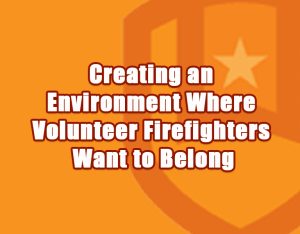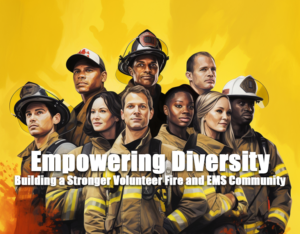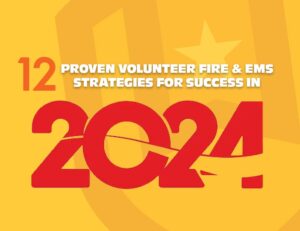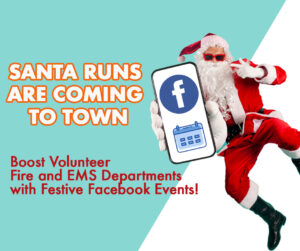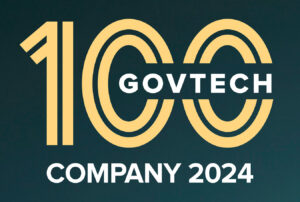VP of Strategic Services, Tiger Schmittendorf is collaborating with the National Volunteer Fire Council on a series of recruitment blogs and webinars as a part of the NVFC’s partnership with First Arriving. This article was originally published in the NVFC Dispatch and on NVFC.org.
The term “Volunteer Life Cycle” (VLC) is used to describe all the stages, phases, and events that occur in one’s journey in volunteer emergency services. The purpose of this article is to introduce you to the process of mapping your own personal VLC, and how to identify and address obstacles and barriers to recruitment and retention in order to maximize the volunteer life cycle in your department.
Mapping the VLC
It is useful to map the VLC for your department in order to identify, quantify, qualify, and visualize all the steps in your volunteer management process. It’s only then that you can identify and address the gaps in the process where you are most likely to lose the participation, and thus the value of your volunteers.
The diagram below demonstrating the typical onboarding process for my county’s volunteer fire service suggests that the volunteer life cycle starts at the moment of inquiry and continues through retirement from service. However, one may argue that, just like our size-up of an incident or situation starts well before the alarm bell rings, the VLC starts long before the candidate makes an inquiry. The process may actually start with the candidate’s first introduction to or interaction with emergency services. Perhaps it was a fire station visit, a family influence, a parade of emergency vehicles, or being on the receiving end of our services that first sparked their interest in serving.
Whatever their motivation, one constant is that we need to capture and hold that interest, curiosity, or inspiration early and often in order to enhance and maximize the volunteer life cycle.
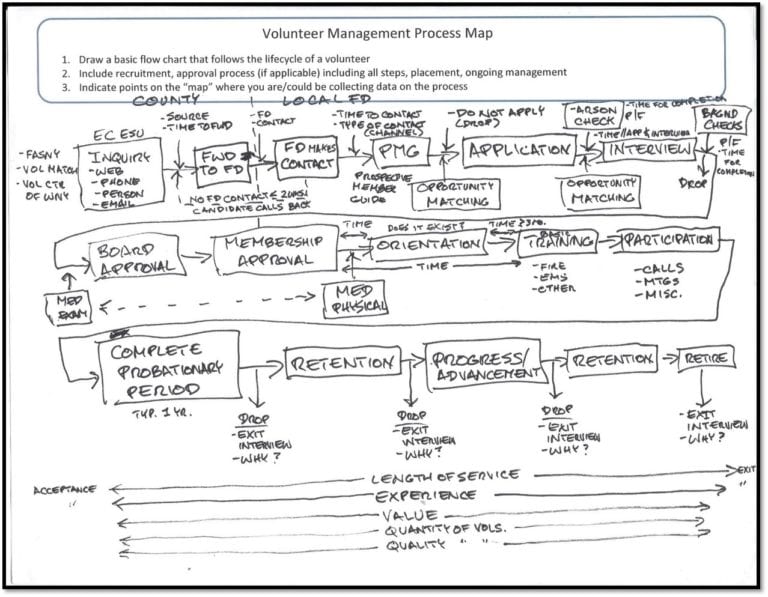
As we look at my hand-drawn diagram (I’m a firefighter, not an artist!), you’ll see that there are several steps involved in the volunteer management process. It’s important to not only frame out the building blocks of that process, but also to quantify the realistic length of time between or during phases of the process. By examining the current length of any one step and comparing it to the ‘acceptable’ length that each step should be, we can then identify steps that are slowing the process, or potential gaps where we’re losing our volunteer’s interest or motivation for joining and belonging, and thus failing to maximize their volunteer life cycle.
A key area to examine is the actual onboarding process, from the point of inquiry to the moment they raise their right hand. How long does it take for someone to go through that process in your organization? Thirty days? Sixty days? Longer? Whatever the length of that phase of the journey, one thing we know for sure, especially with today’s generation of volunteers, is that we need to maximize the quantity and quality of the interactions we have with the candidate in order to give them every opportunity to test-drive our organization and determine if it’s the right fit for them. At the same time, it gives us the opportunity to make sure they’re the right fit for our organization.
Conducting a Recruitment & Retention Assessment
It is also useful to examine the internal and external factors affecting your ability to retain and recruit volunteers by conducting what I call a “Recruitment & Retention Assessment Center.” As shown in the chart to the right, this is an analysis of why people don’t join, join, stay, and don’t stay in your volunteer emergency services agency.
I have found in conducting many Recruitment & Retention Assessment Centers during my “Call to Duty” volunteer recruiter boot camp that the factors affecting retention and recruitment success can typically be lumped into one or more of five categories:
- Life challenges, including family, work, and other time commitments
- Leadership issues, including mis-management, volunteer overload, and lack of respect for the volunteer’s time
- Personal conflict between members
- Lack of awareness by the public that their community is protected by dedicated volunteers
- Personal choices, including fear of the known or the unknown, or a simple lack of genuine interest in volunteering, or at least volunteering in this capacity
Creating an Organizational Snapshot
Another step in determining your department’s recruitment and retention needs and where there are gaps that need to be addressed is to map the demographics of your current membership. Plot each member on a timeline that shows the age at which they joined, their current age, gender, length of service, level of contribution, and, for lack of a better term, team spirit. Maybe you could measure team spirit the same way they ask you to rate your pain level when you arrive for a doctor or emergency room visit, using varying “smiley faces” to describe their organizational outlook and attitude – a morale-o-meter of sorts.
You’ll likely find this organizational snapshot to be very telling, helping you understand the health and depth – the bench strength – of your current membership. In one exercise where I help departments map out the cumulative years of service experience of their membership, I ask them if this next statement describes the make-up of their organization: “You have a stable cadre of members with 15 years of service and up, and hopefully a growing component of members with 5 or less years of service, but in the 5-15 years of service range – you’re real lean.” Many if not most folks nod in agreement and say, “That’s us to a T!”
Not sure if that matches up with your organization? Here’s a fun exercise: the next time you have your entire membership together, divide them by those three categories of range of service: 0-5, 5-15, and 15+, and make them sit in their respective groups separated from the others.
If the three groups are evenly balanced, you likely have a stable organization that values succession and retention. If most of your membership is sitting in the 0-5 years of service group, that’s a sign that your organization is growing through positive recruitment. That’s a good spot to be in, providing there’s ample representation in the other two groups who are hyper-critical to training their replacements. If the majority of your folks are huddled in the 15+ group – you’ve got some recruiting to do and you’d better get busy soon!
But if your membership segregation exercise shows you’re really lean in the 5-15 years of service range, that’s a touchy spot to be in. It’s a potential indication that your mid-range members have fallen victim to the effects of what I call the “Retention Cliff” of the volunteer fire service, having slipped away, fallen off, or having been pushed away when their ability to balance life, work, and volunteering fell on hard times. Unfortunately, nudging, pushing, and sometimes flat-out kicking our valued members over the “Retention Cliff” has left a significant body count of wasted human resources at the bottom of the abyss, never to be recovered and widening that dangerous divide between our well-seasoned and lightly-seasoned members.
As we graph the stability and sustainability of our membership, it’s that sweet spot of training, responsibility, and contributions where our company officers and foreseeable future leaders are derived from. Without that middle-management and mid-range length of service, the formal and informal well-seasoned leaders at the far end of the spectrum are left with no choice but to dig in and remain in those positions of influence longer than they planned to, hoped to, or wanted to, all the while investing more time and energy in ensuring the success of their ultimate replacements.
Another good exercise is to separate your members into the four age groups I’ve identified in the fire service. I categorize young people age 14-18 as the future of the fire service, those aged 18-25 as the backbone, and those 40+ as the knowledge and experience base of the fire service. Those in the age group between 25-40 fall into what I refer to as “the lost years,” a time of significant personal and professional growth and all the associated challenges that come with it. Once the music stops and everyone sits down, look around at the chronological composition of your organization. What is it telling you about the chain of survival of your volunteer fire department? Where and how are you investing in ensuring you have the proper quantity and quality of people to deliver the services you’ve committed to your community?
Turning Knowledge into Action
Whether you conduct your membership assessment live or on paper, I encourage you to map out your organization’s typical volunteer life cycle and identify the point at which you’re must likely to lose a volunteer’s commitment of time and energy. Identify the reason the gap exists, determine whether it’s caused by internal and/or external factors, and then make an honest assessment as to whether you can truly affect the trending issue and reverse its impact on your ability to retain and recruit volunteers. Then prioritize those gaps and use this data to work with a sense of urgency to maximize the life cycle of all of your existing and future volunteers.
While it’s always more about the people than the process, it’s this process that helps you geo-locate where your organization is in real-time, and where your people are in their personal and your organization’s journey ─ all information critical to maximizing the volunteer life cycle.
Click here to learn how First Arriving can help your department with recruitment, retention, membership management, community engagement and more.
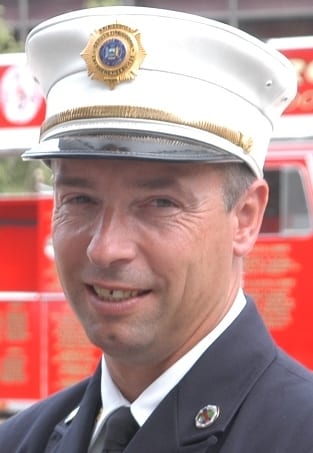 Tiger Schmittendorf is vice president of strategic services for First Arriving, a full-service marketing team supporting the public safety community. He served the Erie County Department of Homeland Security & Emergency Services (Buffalo, NY) for more than 20 years before retiring as deputy fire coordinator in January 2018. There he was responsible for the recruitment, training, and mutual aid operations of the county’s 97 fire departments and 6,000+ firefighters. He created a recruitment effort that doubled his own fire department’s membership and helped net thousands of new volunteers countywide. A frequent presenter on leadership, incident management, connecting generations, and recruitment and retention, he is a nationally-certified fire instructor and has been a firefighter since 1980. Connect with him at tiger@firstarriving.com.
Tiger Schmittendorf is vice president of strategic services for First Arriving, a full-service marketing team supporting the public safety community. He served the Erie County Department of Homeland Security & Emergency Services (Buffalo, NY) for more than 20 years before retiring as deputy fire coordinator in January 2018. There he was responsible for the recruitment, training, and mutual aid operations of the county’s 97 fire departments and 6,000+ firefighters. He created a recruitment effort that doubled his own fire department’s membership and helped net thousands of new volunteers countywide. A frequent presenter on leadership, incident management, connecting generations, and recruitment and retention, he is a nationally-certified fire instructor and has been a firefighter since 1980. Connect with him at tiger@firstarriving.com.


